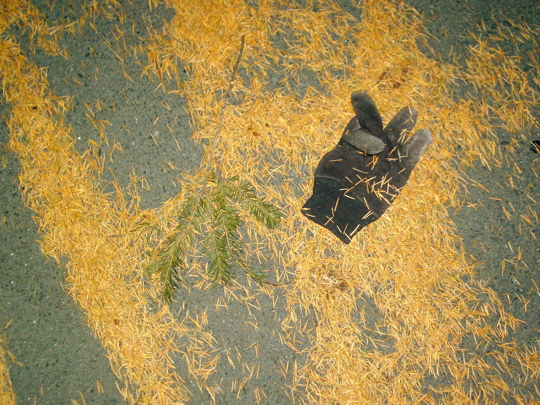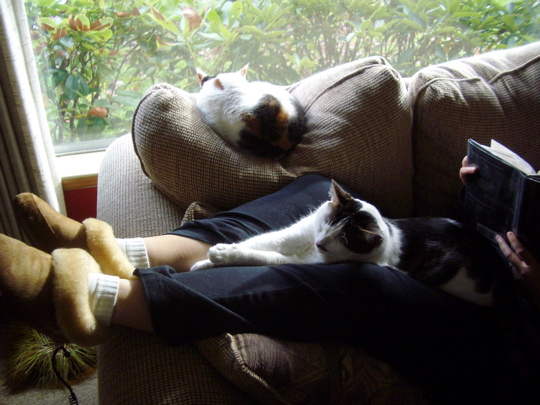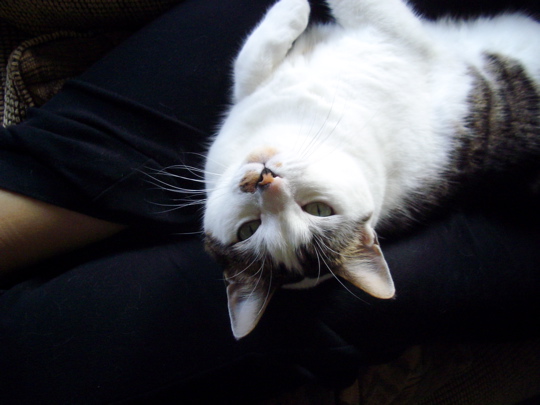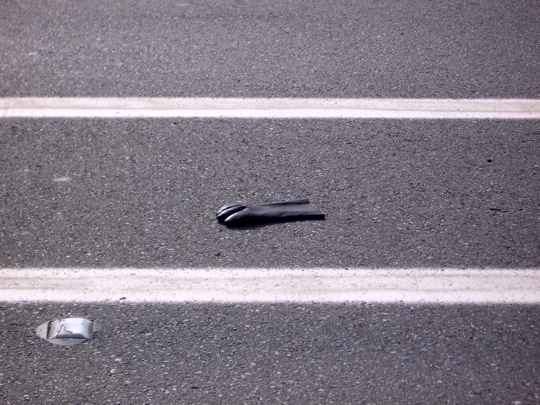October 29, 2005
Lost Glove #64 and a show
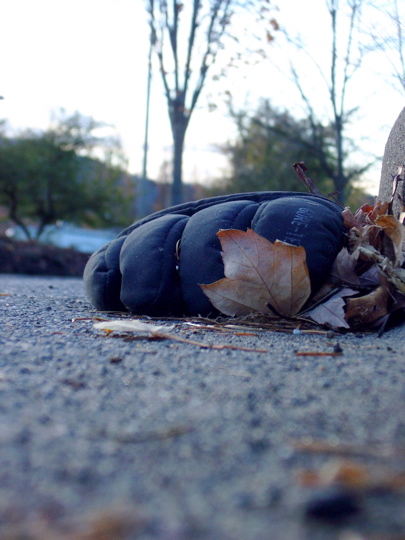
Seen a few days ago on my way from work to dinner.
Becky and her art buddies are having a show and sale in a house up in Everett next weekend and I'll be showing prints of some of my lost glove pictures. The other artists do a wide variety of work from traditional and original paper-cuttings to acrylic paintings to homemade journals to Becky's mixed media stuff. If Everett isn't too far out of your way, I'll stick details and directions after the cut.
Art & Craft Sale
12128 49th Drive SE, Everett, WA
Saturday, November 5, 10am to 4pm
Sunday, November 6, 10am to 4pm
Featuring talented local artists
with all original artwork:
Acrylics – Watercolors – Collage
Photography – Fibers – Paper-cuttings
And more!
Get your Christmas shopping done early with one-of-a kind gifts. Find something extraordinary for yourself. You will love what you see and want to take it all home! Come fill your day with art and meet the artists, too. We hope to see you!
Directions:
The Goodpastures
12128 49th Drive SE
Everett, WA 98208
1. Take Interstate 5 to Exit 186 (128th Street EAST).
2. Take 128th Street EAST (after a few blocks, 128th becomes 132nd Street).
3. After 1½ miles or so, you will pass McDonalds's, a Shell station on the right, and a school on the left.
4. Continue and make a left at Seattle Hill Road.
5. Make a left at 51st Avenue SE (very first street on the left).
6. Go past two stop signs.
7. Make a left on 122nd Street SE.
8. Continue and make a right on 49th Drive (corner house with rope fence).
October 21, 2005
Guest cat
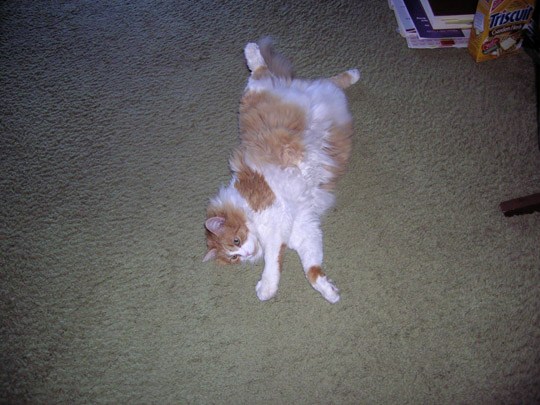
This week we have a guest kitty in the person of Peaches, my sister's cat more recently inherited by my parents. This shot is from back in the hot days of August and out of frame above her there is a ceiling fan. Peaches looks like a sweetheart here, but in point of fact she's kind of a psycho. You don't want to rub her the wrong way or she'll take your arm off.
Picture credit goes to Jerry Youngstrom. Thanks for sharing!
October 16, 2005
The canoe and the starship
Back in 1978, Kenneth Brower wrote a book about Freeman Dyson and his son George. Freeman is a rocket scientist who (among many other things) proposed propelling spacecraft with atomic explosions. George is obsessed with the kayaks of the Aleutian island peoples. The book was called The Starship and the Canoe.
This week I flipped the order of the topics from Brower's title by attending a lecture about the baidarka by George Dyson at Town Hall on Tuesday, and a panel of rocket scientists (unfortunately not including Freeman Dyson, but still) at the Science Fiction Museum on Thursday.
Read on for what I got out of the two talks...
Dyson told the story both of his beloved Aleutian kayak (baidarka) and of his own journey of discovery as he researched the boat and built his own versions. He illustrated his talk with dozens of historical and modern pictures of baidarkas both traditional and his more avante garde models. I wondered whether he was playing up his role in the proliferation of modern sea kayaks, but his presentation was otherwise so self-deprecating that I think he at least believes there's a connection. Since I'd already read Brower's book as well as Dyson's Baidarka (now out of print), there wasn't too much new to me in his talk, but it was fun to put his halting, but intense presentation style together with his work.
Thursday night's lecture brought to mind the phrase "rocket science rock stars" with this lineup:
- Vernor Vinge, richly awarded science fiction author (and also math PhD and long-time math and computer science professor at SDSU)
- Michael Laine, president of LiftPort Inc., a Bremerton company with a 15-year plan to build a working space elevator
- Jordin Kare, freelance rocket scientist and leader in the design of laser launch and propulsion systems.
- Robert M. Winglee Chair of the Department of Earth and Space Sciences at the University of Washington and specialist in plasma propulsion systems.
- Geoffrey A. Landis award winning science fiction author and NASA scientist (currently working on the Sojourner Rover team on the Mars Pathfinder Mission)
Be still my heart!
Vinge started off with a prepared talk that strongly echoed something George Dyson had said on Tuesday. Dyson talked about Jared Diamond's latest book, Collapse and pointed out that the reason the Aleutian indian culture survived for ten thousand years basically unchanged is that their culture existed in scores of different islands in the archipelago with reasonably frequent communication among them. Dyson suggested that this dispersion made their culture resistant to the disruptive forces (war, natural disasters, disease, etc.) that might otherwise have wiped them out wholesale.
Vinge's talk pointed out (at least in my mind) the fact that as long as we restrict ourselves to this one little planet we are vulnerable to potential complete destruction of our species. If we want to survive, we need to pursue long-term self-sustaining human habitats outside of Earth. The primary impediment to this goal is the fact that we sit at the bottom of a deep gravity well. The remaining members of the panel presented their ideas for how to make getting out of that well and into space economical.
The most daring idea is that of Laine's LiftPort, Inc. Their vision is to build a ribbon of material constructed from carbon nanotubes that would stretch from a terrestrial anchor point in a boat on the equator to a point 62,000 miles away in space. A ribbon-climbing robot elevator car could then carry material (and people!) from Earth into space. Laine was up front about the fact that there are a bunch of steps in this plan that aren't currently possible, but the company is taking an interesting approach to the project by trying to develop the technology as they go and use more mundane applications of their work to help fund their ultimate goal.
Jordin Kare is taking almost the opposite approach with his proposal for a laser launch system. The idea of this method of launch is that chemical rockets are almost self-defeating since they need so much fuel to get out to space that they need more fuel just to carry the fuel. So Kare's plan is to build an array of powerful lasers which can target a heat exchanger on the side of a reusable launch vehicle which carries a relatively small quantity of propellant which is heated to propulsion temperatures by the lasers. Kare maintains this plan is doable with current or very near future technology and even better can be tested on a small scale instead of requiring billions of dollars to get to a prototype. Of course the small scale trial still needs millions of dollars so it's not completely trivial (otherwise it would already be done!)
Winglee's pet project is not a launch system (at least I don't think there were launch applications of this technology), but instead a method of moving spaceships around the solar system. One approach is to utilize an electromagnetic field sail to propel a ship using the continuous rain of plasma particles being sent out from the sun. He also talked about direct plasma drive systems. It was cool that his research is being conducted right here at the UW.
Finally, Landis gave a presentation about the why, what, and how of interplanetary travel and colonization, talking about the possibilities presented by the various celestial bodies from our moon to floating habitats in the clouds of Venus to the moons of Jupiter and Saturn.
It was exhilarating to hear these passionate scientists talk about their visions for the exploration and coloinzation of our solar system.
The audience had a bunch of extremely erudite questions including the one I expected referring to the catastrophic failure of a Martian space elevator in Kim Stanley Robinson's Mars trilogy. Apparently while that scenario was good science at the time, more recent scholarship indicates such a catastrophe is not a likely outcome. (And Robinson himself will be making this point in an essay to be published in an upcoming collection about space elevators commissioned by LiftPort)
Someone asked what we can do to get some of these ideas implemented. Laine jokingly suggested, "write a check," but acknowledged, along with the other panelists that the question is largely political. Like all political questions the answer is to let those in power know that these issues are important to you (or as one audience member pointed out to run for office yourself!)
October 14, 2005
October 11, 2005
Streamlined schedule
This area has two different transit agencies as an artifact of the insane measures it takes to pry open the wallets of our car-centric neighbors to pay for public transportation.
Metro is the principal system with express routes, local routes and milk runs across the region. Metro's schedules are provided on a route-by-route basis in the form of little folded single sheets you can tuck in your pocket. You still have to pick up new ones for the routes you use about every six months since they can't seem to leave the schedules alone for longer than that (for example, the 200, a jitney that runs all around Issaquah had a single one of its daily runs shifted recently)
Sound Transit is the newcomer funded by a ballot measure a few years back. They've taken over most of the express bus business from Metro and also do some heavy rail commuter routes as well as oversee the construction of the new Seattle light rail line. Sound Transit schedules are all published in a single staple-bound book about the size of a small trade paperback.
Neither system provides a decent way to print out a single route schedule from their web page.
I live in Issaquah where only one Sound Transit route is relevant to me, the 554 which runs in a relatively speedy 30 minutes from Issaquah to Seattle. I didn't want to schlep around their novel of schedules so I'd know the details for this one route, and I didn't want to print out the 10 pages of paper it would take to print it out (plus the aggravation of having to use IE since their printable view doesn't work in the standards-compliant browsers).
So I scraped their four different pages of 554 info and recombined them into a single page suitable for printing 2-up double-sided for a one-sheet printable Sound Transit 554 schedule. Which I provide to my fellow Issaquanians with my compliments.
October 09, 2005
Cat in the box
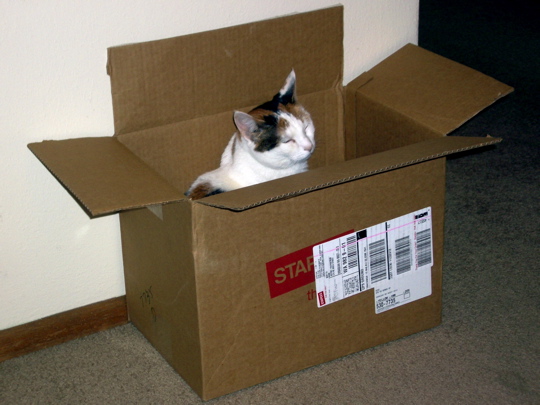
Late again. On Friday we went to see Don Quixote at Book-It! with friends (don't bother. It's way too long a book to survive the Book-It! treatment intact.) and got back late enought that I didn't feel like hunting down a picture to post, then yesterday I had a little computer fast. I'll try to plan ahead for next week and get back to Fridays.
October 05, 2005
October 03, 2005
Found gloves
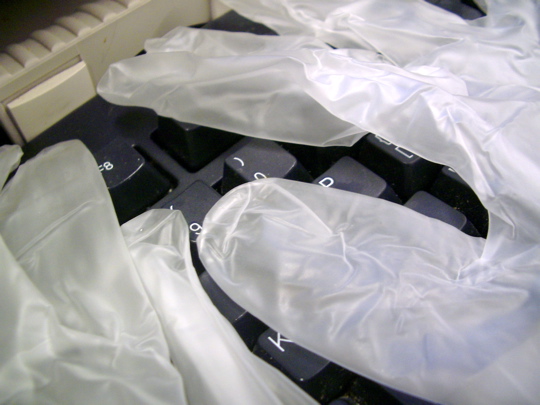
At work this weekend I was doing some maintenance that required me to visit a large number of my coworkers' computers. I started laughing when I got to this one and saw the pair of disposable gloves draped across the keyboard. There's some ambiguity about whether the gloves were intended as a comment on my glove habit or as a prophylacitc measure against the grungy keyboard. I suspect it was a little of each.
October 01, 2005
Balance is everything

I was working late last night so we've got Saturday cat blogging. One advantage to having enormous feet (and it's good that there's at least one) is that Theo can comfortably fit in the boxes my shoes come in.
Socks!

Our friend Wendy made us socks! How cool is that? I wouldn't have even realized that socks were something you could make except Tara makes them too.
